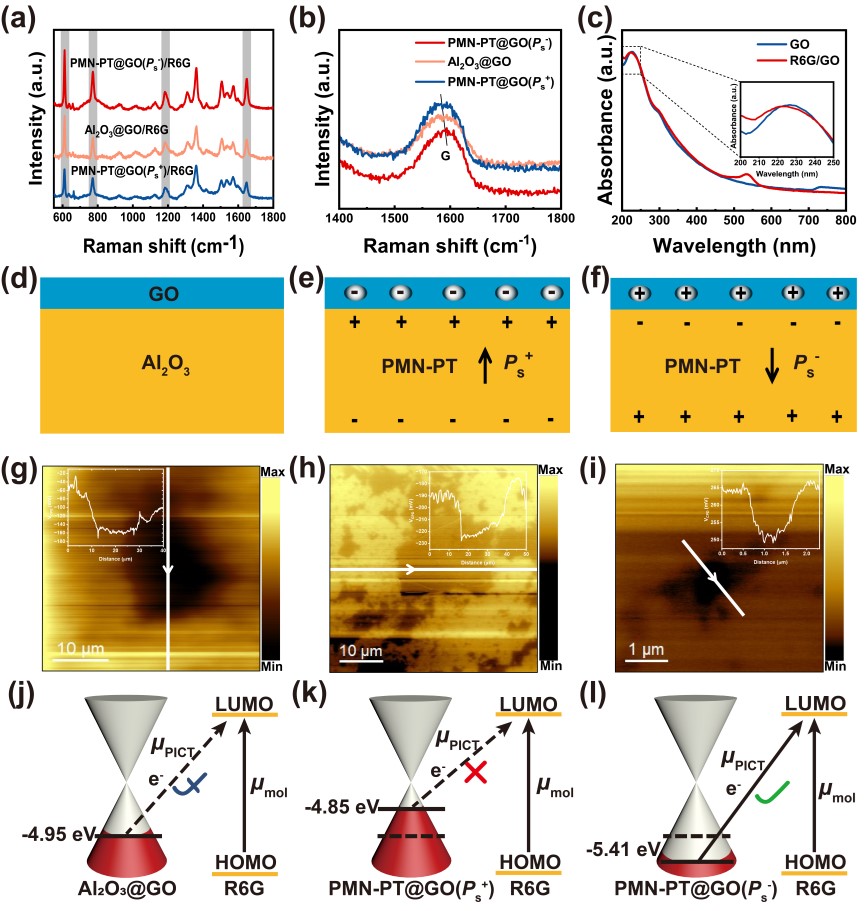| Nov 03, 2023 |
Graphene oxide band tuning enhances Raman sensing
(Nanowerk News) Scientists have developed a new strategy to significantly boost the sensitivity of graphene-based sensors that detect molecules using Raman spectroscopy. By modulating the graphene's electronic band structure, the researchers were able to optimize the energy required for probing various molecules. This advancement provides a versatile platform for enhanced sensing across a wide range of target analytes.
|
|
The findings have been published as open access in Opto-Electronic Advances ("Ferroelectrically modulate the Fermi level of graphene oxide to enhance SERS response").
|
 |
| Schematic diagram of ferroelectric modulation of Fermi level in graphene oxide. (© Opto-Electronic Advances)
|
|
Raman spectroscopy relies on the inelastic scattering of laser light by molecules to determine their chemical structure and composition. The efficiency of this technique is greatly increased using graphene-based substrates, an approach known as graphene-enhanced Raman spectroscopy (GERS). There are two mechanisms behind GERS - an electromagnetic effect from graphene's unique optoelectronic properties, and a chemical effect based on interfacial charge transfer between graphene and the probed molecule.
|
|
While the electromagnetic boost has been well studied, optimizing the chemical contribution by aligning graphene's band structure with the target molecule could further improve sensitivity. This requires tuning the relative positions of the energy bands between graphene's conduction band, valence band, and Fermi level with the highest occupied and lowest unoccupied molecular orbitals (HOMO and LUMO) of the analyte. The resulting band alignment facilitates photo-induced charge transfer and enhances the Raman signal.
|
|
To achieve this band tuning, researchers from Shandong Normal University in China coupled graphene oxide (GO) nanosheets with the ferroelectric material PMN-PT. They leveraged the intrinsic electric polarization of PMN-PT below its Curie temperature to electrostatically dope the GO, shifting its Fermi level based on the polarization direction. This provided a flexible way to optimally align GO's band structure with different probe molecules by simply changing the temperature.
|
|
Using PMN-PT's downward polarization, the team enhanced GO's p-type doping, moving its Fermi level closer to the HOMO of the test molecule rhodamine 6G. This better matched the photon energy of the probing laser, boosting the efficiency of photo-induced charge transfer. Consequently, they achieved a 100-fold improvement in sensitivity, detecting rhodamine 6G at concentrations down to 10-9 moles per liter.
|
|
More significantly, modulating the polarization strength by varying the temperature allowed detection of multiple molecules with different band structures. Crystal violet and methylene blue were optimally sensed around 0°C, when stronger polarization induced heavier p-type doping in GO. However, the aromatic compound p-nitrothiophenol required weaker polarization and higher temperatures around 40°C. The researchers could easily switch between these conditions to enhance the Raman signal from each analyte.
|
|
This on-demand band alignment using temperature-controlled ferroelectric doping provides a versatile sensing platform. The graphene-ferroelectric coupling methodology could be extended to other 2D materials, enabling optimized chemical enhancement across diverse target molecules. By simply tuning the temperature, the same substrate can detect various analytes without redesigning the sensor architecture.
|
|
The flexibility and sensitivity of this approach has significant potential for real-world applications like medical diagnostics, environmental monitoring, and quality control in pharmaceuticals. Further development could integrate this material system into portable Raman spectrometer devices. With optimization of the substrate and probing laser, researchers envision enhancing detection down to the single molecule level.
|
|
This research provides new insights into the chemical mechanism behind graphene-enhanced Raman spectroscopy. Electrostatic doping using ferroelectrics offers a convenient way to harness this effect and boost Raman sensors' performance. The capacity to actively modulate band alignment unlocks versatile, highly sensitive chemical analysis of multiple target molecules using a single platform.
|

